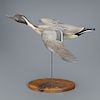The Combs Flying Pintail Decoy, Capt. George W. Combs Sr. (1911-1992)
Lot 353
About Seller
Copley Fine Art Auctions
20 Winter Street
Pembroke, MA 02359
United States
Founded in 2005, Copley Fine Art Auctions is a boutique auction house specializing in antique decoys and American, sporting, and wildlife paintings. Over the course of the last two decades, the firm has set auction records for not only individual decoy makers, but also entire carving regions. Copley...Read more
Estimate:
$50,000 - $70,000
Absentee vs Live bid
Two ways to bid:
- Leave a max absentee bid and the platform will bid on your behalf up to your maximum bid during the live auction.
- Bid live during the auction and your bids will be submitted real-time to the auctioneer.
Bid Increments
| Price | Bid Increment |
|---|---|
| $0 | $50 |
| $1,000 | $100 |
| $2,500 | $250 |
| $5,000 | $500 |
| $10,000 | $1,000 |
| $25,000 | $2,500 |
| $50,000 | $5,000 |
About Auction
By Copley Fine Art Auctions
Jul 25, 2019
Set Reminder
2019-07-25 10:00:00
2019-07-25 10:00:00
America/New_York
Bidsquare
Bidsquare : The Sporting Sale 2019
https://www.bidsquare.com/auctions/copley/the-sporting-sale-2019-4227
July 25 at 10 am | 550 lots Copley Fine Art Auctions cinnie@copleyart.com
July 25 at 10 am | 550 lots Copley Fine Art Auctions cinnie@copleyart.com
- Lot Description
Capt. George W. Combs Sr. (1911-1992)
Freeport, Long Island, NY, 1935
26 in. long, 25 in. wingspan
This bulling pintail is considered to be the finest flying gunning decoy known to exist. It has remained largely out of the public eye since winning a ribbon at the famous 1948 Natural Decoy Makers contest. It has resided in the Combs' family rig and collection, since George Sr. created it for his gunning rig eighty-four years ago.
True flying decoys are exceedingly rare as they were more challenging to create and transport than their floating counterparts. Those that were made were prone to significant damage, resulting in very few surviving into the decoy-collecting era. Indeed, this bird has a repair by the maker to its left wing tip.
Most vintage flying waterfowl collected today were made as decoratives with fine examples by Crowell and Hudson adorning many top collectors' walls. The majority of flying hunting decoys are brant from New Jersey and California by makers such as George Gaskill, Ellis Parker, Avon Merlini, and George McLellan. A review of the “Hundred Greatest” book reveals only one such flyer, a black brant by McLellan. Ira Hudson is one of the only top-tier makers that produced flying decoys, with just two Canada geese known. Combs apparently had a penchant for experimenting with flyers; Henry Stansbury documents a “Hudson flying Canada goose decoy from the Combs rig… used on Long Island Sound in the 1930s.”
This on-the-wing sprigtail captures a perfect balance of folk art and realism. This lively, animated form demonstrates the work of a highly skilled craftsman with intimate knowledge of his subject. The body and wings are canted slightly to the left simulating a banking flight. The outstretched head is angled upward and evokes a drake in pursuit of a hen.
Combs is remembered as an innovator, informed by the past and making improvements along the way. The Combs rig Hudson goose is heavy and its wings were lost. Combs made his flyer out of strong and lightweight balsa. As such, it was able to be transported easily and propped up high above the floating decoys in the rig on a thin rod where it could move with the wind. Unlike many of the aforementioned brant, there was no canvas to tear and puncture. Like the best shorebirds of Elmer Crowell and William Folger, the stick hole is lined with a metal sleeve. It now rests on a rod mounted in a wooden base finished with a plaque naming the maker and hunter "Captain George W. Combs Sr." Signed and dated “G. W. Combs, Sr. 1935” on the underside of the left wing. Original paint with working touch-up to some flaking and wing tip repair by the maker.
Provenance: Capt. George W. Combs Sr. Rig
Private Collection, by descent from the above
Literature: Henry H. Stansbury, "Ira D. Hudson and Family," Lewes, DE, 2002, p. 99, flying Hudson goose illustrated.
Robert Shaw, "Bird Decoys of North America," New York, NY, 2010, p. 210, flying Hudson goose illustrated.
Please email condition report requests to colin@copleyart.com. Any condition statement given is a courtesy to customers, Copley will not be held responsible for any errors or omissions. The absence of a condition statement does not imply that the lot is in perfect condition.Condition
- Shipping Info
-
Shipping info
Copley Fine Art Auctions does not handle the shipping of any items. Shipping is the sole responsibility of the buyer. Once your payment has cleared, and we have received your authorized shipping release form items may be released for shipment. Copley Fine Art Auctions, LLC shall have no liability for any loss or damage to such items. Buyers should allow up to four weeks for shipment.Please be aware that internet bidders may NOT not pick up their items at the sale. Items will be available for pick up by appointment or by shippers five days after the sale.
-



 EUR
EUR CAD
CAD AUD
AUD GBP
GBP MXN
MXN HKD
HKD CNY
CNY MYR
MYR SEK
SEK SGD
SGD CHF
CHF THB
THB
















